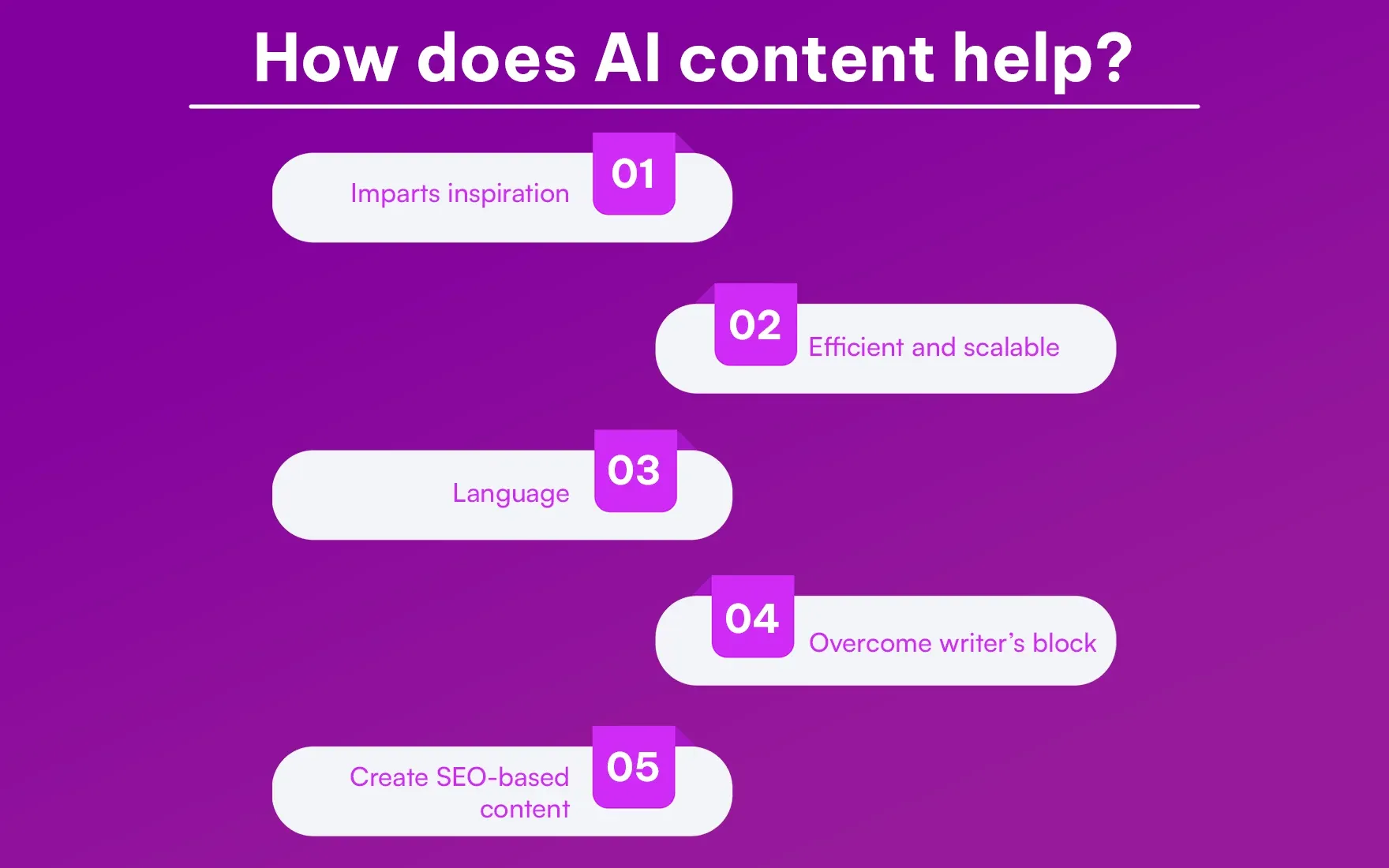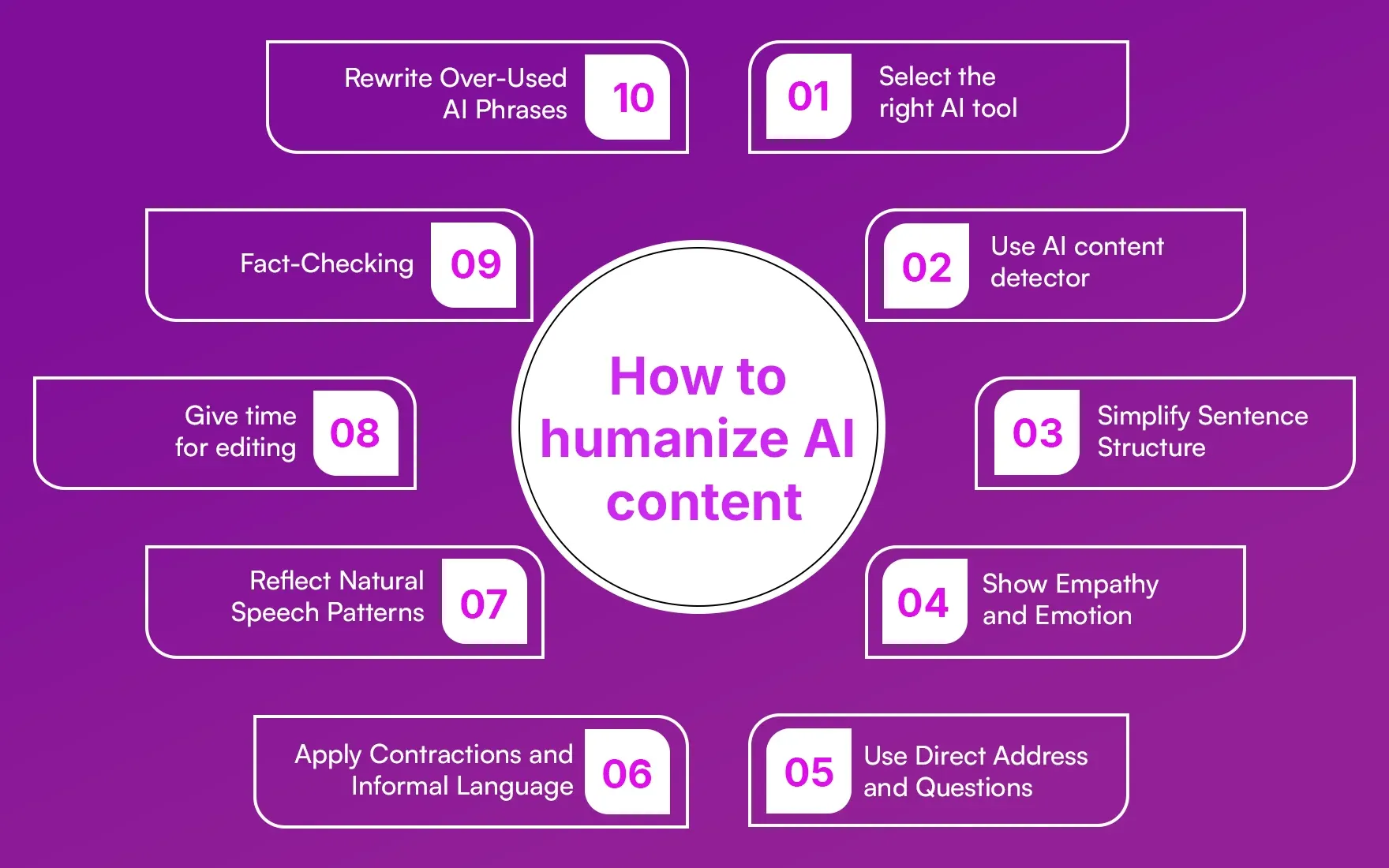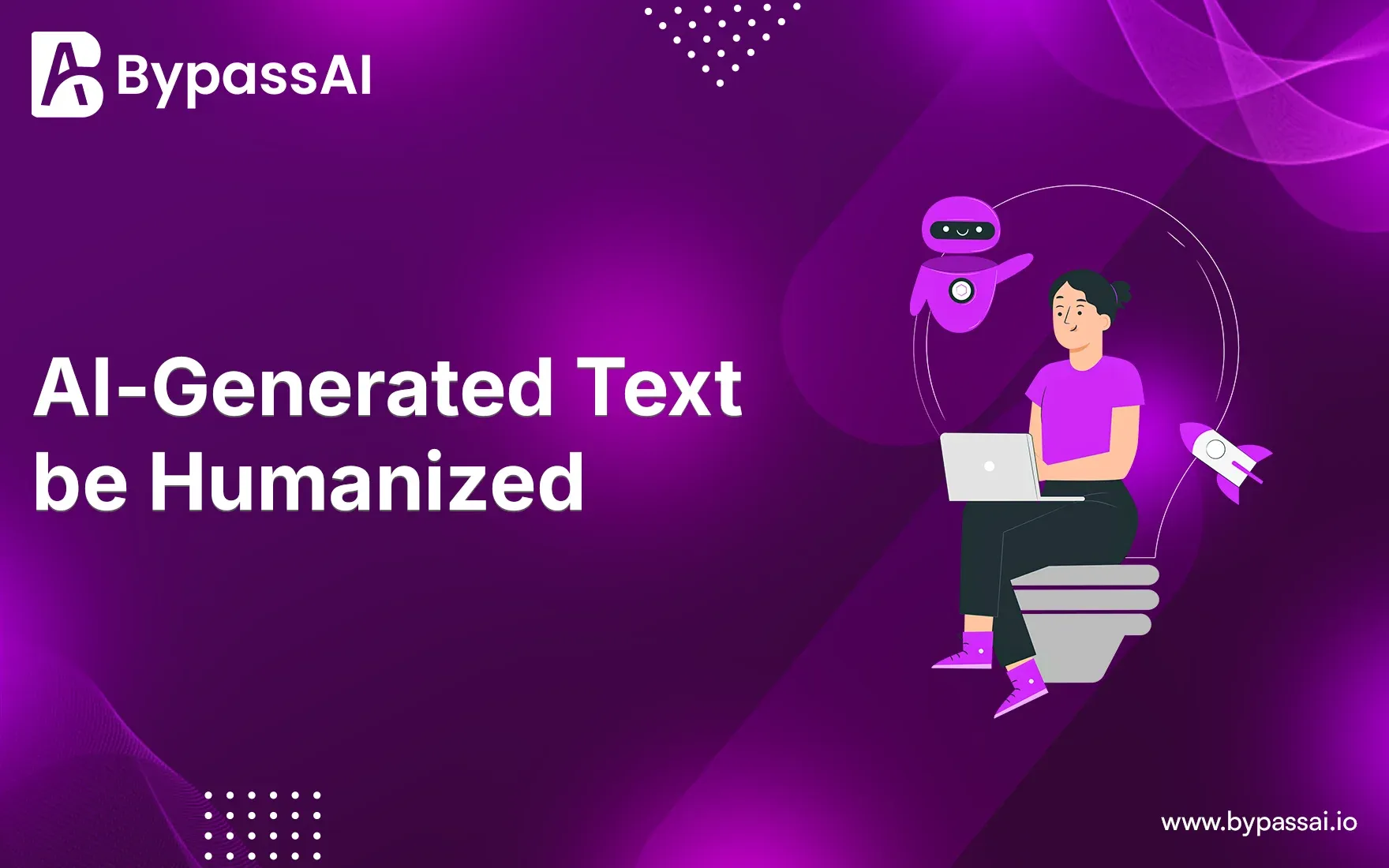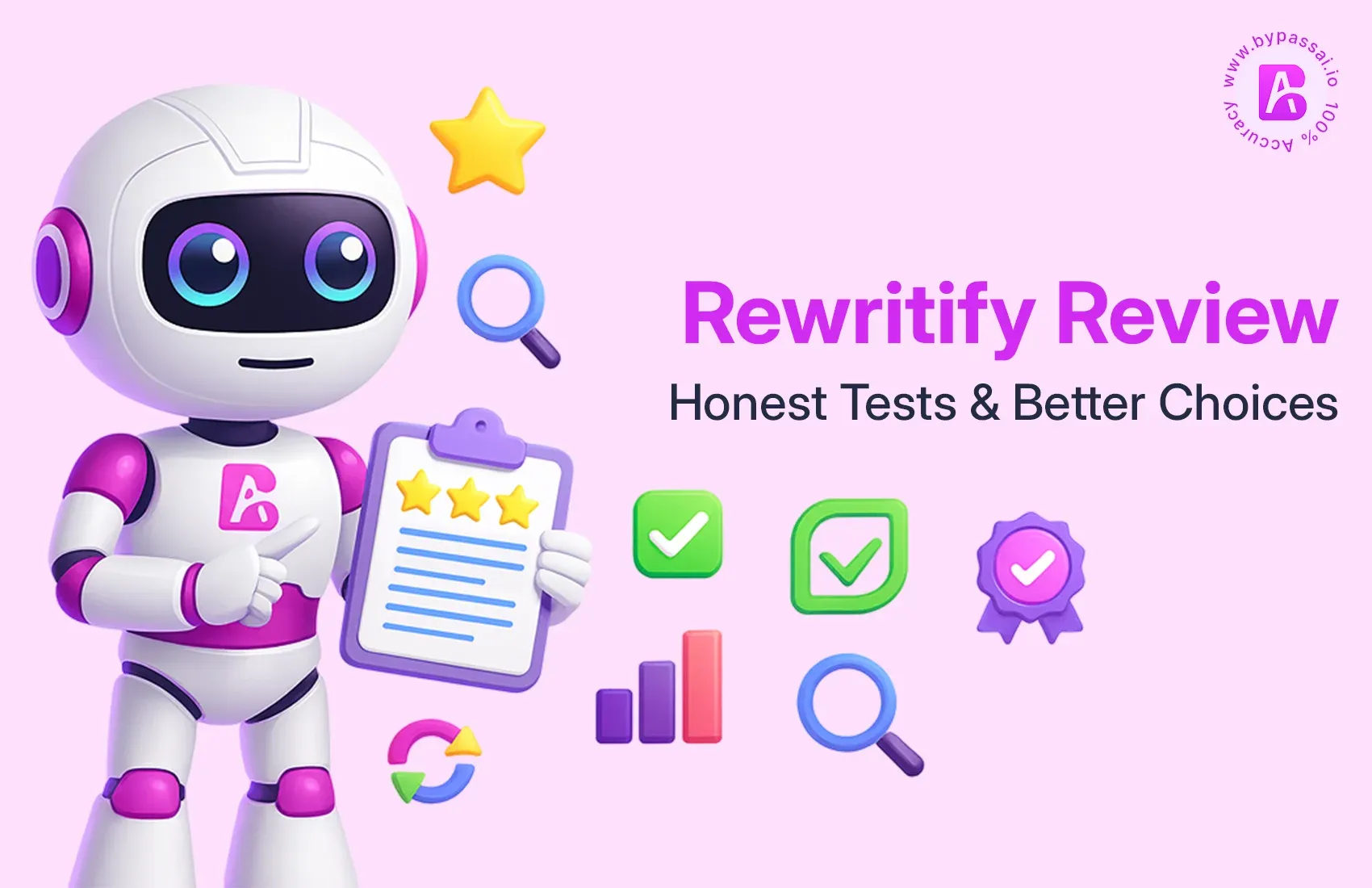Sign In
Welcome to Bypass AI! Sign in to continue your exploration of our platform with all its exciting features.
Forgot Password?
Don’t have an account ? Sign up
Sign Up
Embrace the Future with Bypass AI! Sign up now and let's rewrite the possibilities together.
You have an account ? Sign In
Enter OTP
We’ll send you an OTP on your registered email address
Back to Login
Forgot Password
We'll Send You An Email To Reset Your Password.
Back to Login
Enter OTP
We'll send you an email to reset your password.
Back to Login
Confirm Password
Please enter your new password.
TABLE OF CONTENTS
Quick Summary
What is AI-generated content?
How to determine which AI-content needs "humanizing"?
How does AI content help?
How to humanize AI content
Humanize AI Text With BypassAI IO
Conclusion
FAQ
Nowadays, artificial intelligence, or AI, is key in creating content. It helps write full articles and social media posts, changing how we share and digest data. Still, fast and efficient AI-written text may miss a human element, something readers connect with. This piece discusses why we should add a human feel to AI-created content and offers handy tips to make it more accessible and captivating. Mixing AI skills with human imagination, we can produce content that's not just enlightening but emotionally gripping too.
Quick Summary
Text made by AI, from tools like ChatGPT and Grammarly, uses machine-learned logic based on human input. While quick and helpful, they sometimes lack a personal touch and original thinking. It's vital to make AI text more human-like to form stronger bonds, boost search engine position, and whip-up fresh ideas. Spotting where text needs a human touch, and applying simple methods like easier sentence formats, showing understanding, casual language use, and cross-checking facts can greatly boost the value of AI-made text. By mixing these tactics, we can lessen the distance between AI's speed and the genuineness of a human, making content that truly speaks to readers.
What is AI-generated content?
AI-generated text describes pieces of text or ideas created using machine learning-based human data rather than traditional text This can be the creation of anything from a full-length text to a Facebook ad image. Some tools also offer AI image generation.
While ChatGPT has garnered most of the headlines lately, there are a wide range of AI tools that can help generate content. Odds are you've used one yourself before, whether it's a chatbot like ChatGPT or a tool like Grammarly, which uses AI to help improve the readability and grammar of your text In fact, adding AI to things a the system is not new, it is just being used in other ways.
Why Humanize AI-Generated Text?
If you also don’t know why you should Humanize AI-Generated Text, here are some reasons to start implementing the tips above.
- Lack of Human Understanding: While AI authoring tools often use natural language processing (NLP), they generally lack the strong emotional intelligence necessary to tell a proper story
- Search engine preference: Search engines love quality content that engages users. AI-powered content can be humanized to improve rankings, and help your target audience find you. This also applies to research papers posted on websites such as ResearchGate.
- Emotional connection: Readers want to be able to relate to your work and the points you make. Humanizing AI-generated content creates an emotional connection that can help more people better understand your business.
- Creative edge: AI text for humans brings creativity to content. This allows you to deliver original, innovative ideas that differ from conventional, robotic writing.
How to determine which AI-content needs "humanizing"?
When it comes to common applications like defining words, defining a term, or building a dictionary of words, AI features work like magic.
However, the verbal approach helps people connect with the brands. When we read novels like “The Valkyrie” or “The Lion Tamer Who Lost,” their chaotic yet beautifully connected plots keep us invested in the book as a whole.
He uses the power of writers or writers’ imaginations to create stories that people resonate with and remember for years to come. Similarly, online content is not limited to education. It is meant to raise awareness and leave an impact on lives. The AI uses training and online data to make conclusions based on feedback, often a slurry of words that make sense but don’t convey any ideas
Hence the answer to our previous question, “Do you need to turn AI content into human content?”
How does AI content help?
The online world is undergoing a massive transformation as every possible website uses AI features in order to make it easier for users.
AI has many pros for the content community, major ones are:

1. Imparts inspiration
AI is an endless source of information. Mind is one of the key use cases for AI tools. They help summarize long articles like Wordtune’s “Read and Summarize” tool and get inspiration by turning off the main lights.
Not only this but even if you spend hours in the search engine console, there are times when you don’t get the information you need. AI comes to the rescue because it is trained to process information, and its mind is like a central place where you can analyze any issue.
2. Efficient and scalable
AI can generate content in seconds.
It sees need and responds faster than humans. A writer can be an expert in writing, because they can use AI to write a story and then edit the whole story according to their needs.
This also takes hours and days when it comes to long posts.
It also helps writers increase their creativity by producing multiple stories in an hour.
However, authors should be careful to avoid pulling all content from AI. Use it for inspiration and take the play off, but always include a brand voice and other important elements.
3. Language
There are about 6,500 languages in the world.
There is a good chance that the next person you meet will speak another language. Living in this diverse world, writers need to capture audiences from different parts of the world.
There are two roads around it.
Learn many languages, and it will take years.
Use AI to transcribe in any language in minutes.
The first option requires an investment of money and time, which we know is rare. The second option, on the other hand, is largely free, cost-effective and time-saving.
Many online AI tools are making their content available in different languages, helping to broaden audiences and meet global needs.
This feature helps add personalization and eliminates the need to learn multiple languages, which can take months or even years.
4. Overcome writer’s block
Writer’s block is just when your brain is out of ideas.
You try hard, but all you get is sarcasm.
To get rid of this problem, you need to go for a walk, do other things, or relax.
What if you race the clock?
When you need quick ideas, AI is the best way to find answers to nagging questions. To help overcome an obstacle, AI carefully analyzes the points and specifics of your presentation and creates a response that best matches your thinking.
This triggers thoughts back into your mind and helps you get out of a rut and start fresh. In some cases, AI can even be used to create entire products. All that is needed is to clear authors to meet publishing standards.
5. Create SEO-based content
Analyzing thousands of online search results every day, AI knows how to use keywords cleverly.
With this wealth of information, AI results are complemented by searches and keywords, helping to rank your content better.
Authors can also get keyword suggestions from AI to help them write relevant articles and research most in depth. This gives authors a foundation from which to work and adds more context to what they publish.
To maximize the quality of their content, writers can use tools to eliminate grammatical errors, rewrite content, shorten, expand, or add a different voice to their content.
Also read this article : 10 Best Undetectable AI Tools to Humanize AI Text
How to humanize AI content
To humanize ai-generated text, you need to intuitively understand the content from the perspective of your audience.
The best way to start is to define your audience’s needs, goals, and emotional impulses. There are other aspects that are considered to humanize content; The most important ones are:

1) Select the right AI tool
AI has written a number of tools online. Each offers a USP (Unique Selling Proposition), such as 10 free rewrites, a meta description generator, and Wordtune’s “Spices” feature.
However, some tools are as efficient and accurate as others. Many are still in beta, while others are developing as the online world evolves.
2) Use AI content detector
Once you’ve created your content, you can run it through an AI content detector, making sure it’s not flagged as AI-generated.
This extra step serves several purposes:
- It reduces some of the manual work of humanizing your content, allowing you to focus on areas that are considered AI-created.
- It prevents Google from flagging your content as AI-generated and hurting your rankings and SEO.
- If you are submitting information for review, and you do not want the reviewing team to know that you used AI. This may sound stealthy, but it actually uses a public speaker and wants the audience to believe that you wrote the speech.
3) Simplify Sentence Structure
The AI's output can be pretty monotonous, coupled with robotic fatigue. Varying the length and structure of your sentences adds rhythm and flow, making the reading experience more dynamic.
Short sentences can emphasize main points; Long, complex sentences allow you to delve into nuances and ideas. Diversity reflects natural human language, helping readers stay engaged.
Additionally, sentence structures help clarify meaning and improve storytelling, making the text as a whole more engaging and relatable. The best part about this strategy? It’s simple but super effective.
4) Show Empathy and Emotion
It is important to include empathy and emotion to resonate with the reader. These inclusions address the reader’s emotions, challenges, and goals. Statements like “We’ve all been there” or “It can be frustrating when…” make sense. Although AI has come a long way, it still doesn’t adequately reflect human emotions.
Always look to address the reader’s emotions and empathize with their experiences. That way your writing feels more supportive and authentic.
5) Use Direct Address and Questions
Speaking directly to readers and asking them questions brings AI-powered content closer to human writing. Phrases like “Have you ever wondered…” or “You might be surprised…” engage the reader personally. It turns content into a conversation rather than a monologue. Are you going where we’re going with this?
Questions encourage readers to reflect on their own experiences, making the text less objective.
6) Apply Contractions and Informal Language
Unless you are writing a technical or legal document, use italics. Use “don’t” instead of “don’t” and “this” instead of “is”. This is how people talk in real life, thus giving AI-generated text a relaxed conversational tone.
Interruptions and informal speech are a great way to break the rigidity associated with artificial intelligence. The use of simple, everyday words and casual words gives the text a warmth and approachability.
But remember to strike an appropriate balance between informality and plain language to maintain professionalism by making text legible.
7) Reflect Natural Speech Patterns
It uses the sounds, intonations, and pauses familiar to spoken language. Spoken words and sentence fragments are a great way to add a human emotion, and show how people actually talk.
Embrace these patterns and let the content flow naturally, reducing the machine sensitivity of AI-generated content. However, it is important to maintain clarity so that the text is not too subtle.
8) Give time for editing
When using AI for stories, editing plays an important role in bringing the stories to justice.
Most of the work you do while editing will include adding voice to the content, extracting general facts, and adding specific data-driven analysis.
You also need to add a human-like conversational voice to make it engaging and unique. Then, find the flaws in the story and eliminate them one by one. Hand editing provides the satisfaction of double checking and humanizes the content.
9) Fact-Checking
When it comes to humanizing AI-authored content, reality checks should never be abandoned. Precision and reliability build credibility, especially in higher education. Although AI content generators use the same data sources as humans, errors can still creep through.
Carefully check facts, dates, and figures to make sure everything is legible. Cross-reference all your sources, especially on sensitive or controversial topics.
10) Rewrite Over-Used AI Phrases
Rewriting overused AI sentences gives your content new life. Some AI tools rely on iterations, which is why results are so predictable. Identify and rework these complexities to make your writing more in line with that of human authors. This also allows you to stand out in a classroom where everyone else may rely heavily on unwritten text with unpolished AI.
Instead of following the same predictable pattern, go for creative words and sentence structures. Create content that best matches your unique writing style.
Humanize AI Text With BypassAI IO
BypassAI IO is a powerful AI text humanization tool that turns AI-generated text into engaging, human-like text. It uses advanced algorithms to recode text from ChatGPT, Gemini, Copilot, Claude, and other AI systems, ensuring content is undetectable by AI detectors while maintaining readability and authenticity BypassAI IO does perfect for writers, content creators, students, and professionals who want to create high-quality, SEO-friendly content that connects with their audience without being flagged as AI-generated.
Conclusion
AI-generated content has revolutionized how we produce and eat information. However, as powerful as AI is, there is still an irreplaceable human contact that it can't reflect. By humanizing AI-generated text, we can bridge the space between efficiency and authenticity, making content greater, engaging, relatable, and powerful. Whether it's enhancing emotional resonance, adjusting language for readability, or ensuring actual accuracy, humanization helps maximize the potential of AI tools while retaining a non-public touch. As AI continues to evolve, so ought our technique to integrate its abilities with human creativity. Start incorporating these techniques today to create content that actually resonates together with your audience.
FAQ
1. Why is it vital to humanize AI-generated text?
Humanizing AI-generated text is critical as it complements the emotional connection between the content material and its audience. It makes the content greater relatable, enticing, and credible, in the long run leading to higher consumer reviews and advanced content performance in search engine ratings.
2. Can AI absolutely update human writers?
While AI can assist and expedite content creation, it can not fully replace human writers. AI lacks the emotional intelligence, creativity, and cultural knowledge that people convey to the writing system. Human writers provide context, nuance, and empathy, that are critical for growing content material that resonates with readers.
3. How can I inform if my content needs to be humanized?
Content that feels overly mechanical, lacks emotional depth, or fails to interact with readers may additionally benefit from humanization. If the textual content is full of commonplace terms, lacks a personal voice, or appears disconnected from the audience's wishes and feelings, it probably wishes for human contact.
4. What gear can assist in humanizing AI-generated content material?
Tools like BypassAI.IO can assist in humanizing AI-generated content material via adjusting tone, improving clarity, and making the text more enticing. Additionally, AI content material detectors can assist pick out areas in the textual content that want in addition humanization.
5. Are there dangers associated with the use of AI-generated content?
Yes, depending too closely on AI-generated content material with out human oversight can result in troubles consisting of real inaccuracies, loss of emotional connection, and capacity penalties from search engines like google for content material flagged as AI-generated. It’s important to balance AI use with human editing and reality-checking to make certain quality and authenticity.





